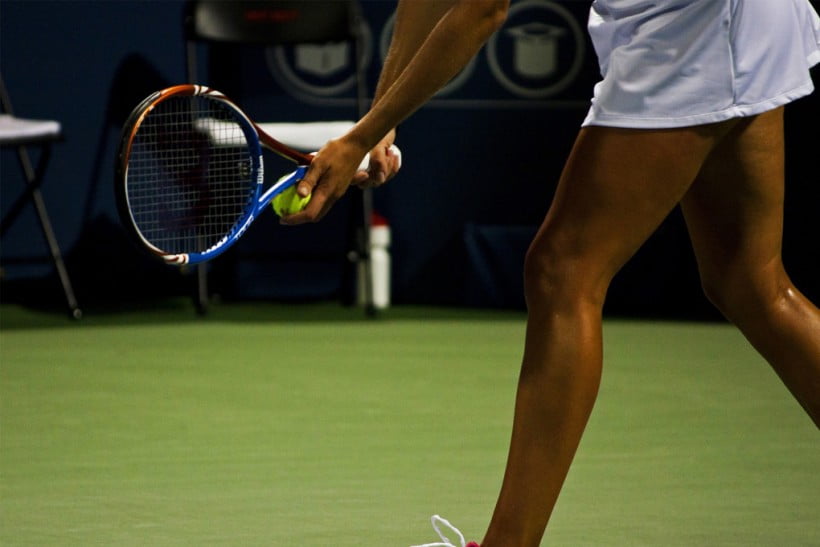Unfortunately the old wait-and-see philosophy, which we have all been guilty of, fails in the instance of tennis serve injuries.

Thickened tendons, bursa and even small tears of the rotator cuff musculature such as the supraspinatus muscle are irritable and easy to re-injure. This is especially so when the position of the shoulder during a serve compresses (impinges) and strains those structures so easily.
Preventing Serving Injuries
Prevention is better than cure and in shoulder tennis serve injuries this includes;
Ensure an excellent technique when serving
(a) The ball tossis incredibly important.
Too low a ball toss and your posture is cramped, ensuring hitting the ball with a rounded shoulder, which increases the chance of impingement. Too high a ball toss and the quick stretch of the arm to compensate in time for the ball to hit the racquet’s sweet spot, increases the chance of overstretching and straining of the rotator cuff musculature.
Practice makes perfect so stand at the baseline, stand upright with racquet fully extended overhead and practice throwing the ball to the sweet spot of the racquet (middle section) without necessarily hitting the ball.
(b) Head and chest position
There is an increasing trend in hitting the ball whilst jumping in the air, with the view of increasing speed and the ability to hit down into the service court. This naturally makes the head drop and the ball to be swung down upon. This chest down position places the shoulder in an increased position of impingement.
Practice serving at half pace with the ball toss arm held up throughout the whole serve to keep the chest in an upward position.
2) Ensure anexcellent warm up and cool down periodbefore training and playing.
Ensure that the neck, middle back, shoulder, torso and wrist are stretched – contact our physiotherapists can help with for specific exercises for tennis warm up and cool down
For example one simple stretching routine before serving could include:
- Pull arm across body, feel stretch not pain, hold for 10 seconds X3
- Walk arm up behind back feel stretch not pain, hold for 10 seconds X3
- Walk arm up wall forwards and sideways, feel stretch not pain, hold for 10 seconds X3
- Slowly at first, but with gradually increasing speed, replicate the tennis serve X6
3) Improve core stability consciously engage (pull in) your stomach muscles whilst practising serving. Speak to our Physiotherapists to show you how!

Rehabilitation After Injury
The exercises listed below are guidance only and should be used in conjunction and advice from our physiotherapists.
For those of us who have pain whilst serving and have begun the process of icing, using anti-inflammatories (if applicable and not contra-indicated by your GP) and have stopped playing, a rehabilitation exercise program can begin. The steps to get back on court include:
1. Initially stretching to regain range of pain free movement. One example is to lie on your back and use a broomstick to stretch arm overhead. This way you can use your unaffected arm to assist in movement. Stop if you feel pain holding for 5 seconds initially.
2. Stabilize the muscles which attach to your shoulder blade and improve your posture.
Strengthening these muscles place the socket of your shoulder in a position to allow the ball of the shoulder joint to spin better and avoid impingement. One example is to squeeze the shoulder blades in and down and hold for 10 seconds. Whilst standing up against the wall feel the pressure of your shoulder blades against the wall and do not let them pull away as you squeeze them together.
3. Ensure neck and trunk muscles and joints are loose with mobilisation and exercises.
4. Strengthen the rotator cuff musculature. The best way is to use theratbue – our physiotherapists have a large array of exercises for this. The most important aspect is to graduate the resistance, the repetition and finally to replicate the serve, attaching theratube to your racquet.
5. Returning to the court to play
Begin with throwing the ball over the net from the service line, working back to the base line. Gradually increase the speed of the throw. Then practice the serve, firstly without hitting the ball and then finally serve with the ball, building up speed.
6. Finally, add in spin and kick serving.
Initially after rehabilitation, icing the shoulder for 10 minutes to prevent an exacerbation of swelling in the shoulder is beneficial.
Essentially, we are assisting Mother Nature in recovering the tissues and muscles in the shoulder that have been injured with serving. It is important that good guidance by our physiotherapists and some patience is required. The most common mistake is to return too soon or to increase the speed and repetition too quickly.
Listening to your body and getting advice will get you back to serving up aces the quickest.

